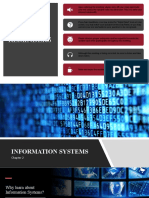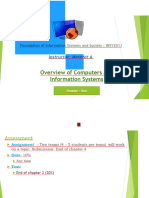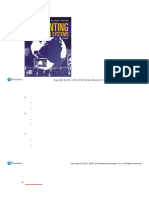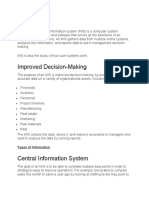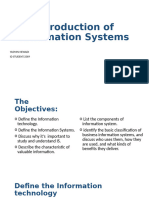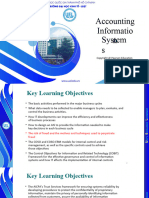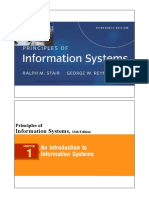Prelim Lesson1
Prelim Lesson1
Uploaded by
steven EstevanCopyright:
Available Formats
Prelim Lesson1
Prelim Lesson1
Uploaded by
steven EstevanOriginal Title
Copyright
Available Formats
Share this document
Did you find this document useful?
Is this content inappropriate?
Copyright:
Available Formats
Prelim Lesson1
Prelim Lesson1
Uploaded by
steven EstevanCopyright:
Available Formats
IM 201
INFORMATION MANAGEMENT
Learning Module on IM201 – Information Management
1
Lesson 01. Information Concepts
Today, we live in an information economy. Information itself has value and commerce often
involves the exchange of information rather that tangible goods. To be effective manager in any area
of business, you need to understand that information is one of an organization’s most valuable
resources.
Lesson Objectives:
At the end of this lesson, you will be able to:
• Define data, information and knowledge
• Distinguish data from information
• Describe the characteristics used to evaluate the quality of data
• Define the terms information technology, information system, computer-based information, and
application.
• Identify each basic component of information system
• Identify the relevance of each basic component as pillars of an effective and successful
Information System
Getting Started:
Information is a central concept of this module. However, the term information is often confused with
data. From the list below, let’s check how well versed you are between the difference of data from
information. Classify which of the following is data and which is information. Write your answers on the
space provided.
_______________1. 28
_______________2. 12*8=86
_______________3. There are 10 people in the room.
_______________4. Bedroom
_______________5. 12/24/1992
_______________6. 1 kilo of sugar
Learning Module on IM201 – Information Management
2
Discussion:
Data
• raw facts, such as an employee number, total hours worked in a week, inventory part numbers or
sales orders
• are raw facts that describe a particular phenomenon such as the current temperature, the price of
a movie rental or your age, the term data is plural and datum is singular.
• refers to an elementary description of things, events and activities, and transactions that are
recorded, classified, and stored but are not organized to convey any specific meaning
DATA REPRESENTED BY
Alphanumeric data Numbers, letters, and other characters
Image data Graphic images and pictures
Audio data Sounds, noises, or tones
Video data Moving images or pictures
Information
• refers to the data that has been organized so that they have meaning and value to the recipient
• is data that have a particular meaning within a specific context
• is a collection of fact organized and processed so that they have additional value of the individual
facts
Knowledge
Learning Module on IM201 – Information Management
3
• consists of data and / or information that have been organized and processed to convey
understanding, experience, accumulated learning, and expertise as they apply to a current business
problem
• the awareness and understanding of a set of information and the ways that information can be
made useful to support a specific task or reach a decision
Example #1
Data representation
Data 95
(numeric)
Data + context +
Information My score on IM 102 final exam is 95%.
information representation
I have passed the exam with Data & information +
Knowledge
excellent remark. meaning & interpretation
Example #2
Mitsuha Miyamizu, 55,000Php, June Data representation
Data
28, 2010 (numeric)
Mitsuha Miyamizu is a sales person
whose monthly salary is 55,00Php Data + context +
Information
and whose hire date is June 28, information representation
2010.
She is a serving the company for 10
Data & information +
Knowledge years and can be considered as a
meaning & interpretation
company asset.
Learning Module on IM201 – Information Management
4
Characteristics of Valuable Information
CHARACTERISTICS DEFINITIONS
Accessible Information should be easily accessible by authorized users so they can
obtain it in the right format and at the right time to meet their needs.
Accurate Accurate information is error free. In some cases, inaccurate information
is generated because inaccurate data is fed into the transformation
process. This is commonly called garbage in, garbage out. (GIGO)
Complete Complete information contains all the important facts.
Economical Information should also be relatively economical to reproduce. Decision
makers must always balance the value of information with the cost of
producing it.
Flexible Flexible information can be used for a variety of purposes.
Relevant Relevant information is important to the decision maker
Reliable Reliable information can be trusted by the users
Secure Information should be secure from access by authorized users
Simple Information should be simple not complex. Too much information can
cause information overload.
Timely Timely information is delivered when it is needed.
Verifiable Information should be verifiable. This means treat you can check it to
make sure it is correct, perhaps by checking many sources for the same
information
Information System is a set of interrelated elements or components (input), manipulate (process), store,
and disseminate (output) data and information, and that provide a corrective reaction (feedback
mechanism) to meet an objective that can be manual or computerized
Components of an Information System
Input in information systems, it is the activity of gathering and capturing raw data
Processing in information systems, it means converting or transforming data into useful outputs; can
involve making calculations, comparing data and taking alternative actions, and storing data for
future use
Output in information systems, involves producing useful information, usually in the form of documents
or reports
Feedback in information systems, it is the information from the system that is used to make changes to
input or processing activities
Learning Module on IM201 – Information Management
5
FEEDBACK
INPUT PROCESSING OUTPUT
Computer-based Information System (CBIS) is a single set of hardware, software, databases,
telecommunications, people, and procedures that are configured to collect, manipulate, store, and
process data into information.
Components of Computer-based Information System (CBIS)
Hardware
• consist of computer equipment used to perform input, processing, storage and output activities;
trend in the computer industry is to produce smaller, faster and more mobile hardware
• consists of devices that accept, process, and display data and information
• input devices include keyboards, mouse, pointing devices, automatic scanning devices and
equipment that can read magnetic ink characters
• processing devices include computer ships that contain the central processing unit (CPU) and main
memory
• output devices include printers and computer screens
Software
• consists of the computer programs that govern the operation of the computer
• is a program or collection of programs that enable the hardware to process the data
• two types: system software such as Microsoft Windows which controls basic computer operations
including start-up and printing and application software such as Microsoft office which allows users
to accomplish specific task including word processing or tabulating numbers
Database
• It is a collection of related files or tables containing data
• an organized collection of facts and information, typically consisting of two or more related data
files; for example, an organization’s database can contain facts and information on customers,
employees, inventory, competitor’s sales, online purchases and much more
Telecommunications, Networks and the Internet
Learning Module on IM201 – Information Management
6
• Telecommunications is the electronic transmission of signals or communications that enables
organizations to carry out their processes and tasks through effective computer networks and can
take place through wired, wireless, and satellite transmissions.
• Networks connect computers and equipment in a building, around the country or around the world
to enable electronic communications; permits different computers to share resources.
• Internet is the world’s largest computer networks, consisting of thousand on interconnected
networks, all freely exchanging information
• Intranet is an internal network based on Web technologies that allows people within an organization
to exchange information and work on projects.
• Extranets a network based on Web technologies that allows selected outsiders, such as business
partners and customers, to access authorize resources of company’s intranet.
People
• are the most important element in most CBIS because they make the difference between success
and failure for most organizations; IS personnel include all the people who manage, run program,
maintain the system, including the chief information officer who manages the IS Department, other
people who work with IS are financial executives, marketing representatives, manufacturing
operators and many others.
Procedures
• include the strategies, policies, methods, and rules for using the CBIS including the operation,
maintenance, and security of the computer
• are the instructions for combining the above components in order to process information and
generate desired output
Learning Module on IM201 – Information Management
You might also like
- MGate MB3000 Modbus Gateway User Manual Version 13.1Document89 pagesMGate MB3000 Modbus Gateway User Manual Version 13.1jorge.raza.ingNo ratings yet
- LH20100601 CanOpen-Pesa-Elf V101Document31 pagesLH20100601 CanOpen-Pesa-Elf V101Rafał BłaszkiewiczNo ratings yet
- Professional Practice in Information TechnologyDocument207 pagesProfessional Practice in Information TechnologySyed Muhammad Junaid HassanNo ratings yet
- Win 11Document5 pagesWin 11Rodrigo CarvajalNo ratings yet
- Lecture 01Document37 pagesLecture 01frankkinunghiNo ratings yet
- Inbound 689259631755627388Document5 pagesInbound 689259631755627388Shecaniah Dawn AragonNo ratings yet
- Im102 Prelim Hand OutsDocument7 pagesIm102 Prelim Hand OutsJeremiah FerrerNo ratings yet
- 1.chapter 1 - Overview Information System FinalDocument131 pages1.chapter 1 - Overview Information System FinalMikiyas AbateNo ratings yet
- BIM Seventh Semester, TU ITC 226: Management Information SystemDocument107 pagesBIM Seventh Semester, TU ITC 226: Management Information SystemRohit ChandNo ratings yet
- Chapter 1 Introduction To Information SystemDocument10 pagesChapter 1 Introduction To Information SystemDevilNo ratings yet
- Foundational Concepts In: Chapter Two MISDocument9 pagesFoundational Concepts In: Chapter Two MISHayelom Tadesse GebreNo ratings yet
- Fundamental Information System TeachingDocument105 pagesFundamental Information System Teachingmulugeta tesfayeNo ratings yet
- Chapter 1. Introduction To Information ManagementDocument57 pagesChapter 1. Introduction To Information ManagementKiburNo ratings yet
- 4s DtyghDocument7 pages4s DtyghGourav ShrivastavaNo ratings yet
- PRESENTATION SYSTEMS THINKING CHAPTER 2 - Information SystemsDocument57 pagesPRESENTATION SYSTEMS THINKING CHAPTER 2 - Information Systemsjerwin dacumosNo ratings yet
- Chapter 1 Slides PostedDocument26 pagesChapter 1 Slides Postedrhania402No ratings yet
- Chapter 1 Business Information Systems RilDocument20 pagesChapter 1 Business Information Systems RilrmlindasorianoNo ratings yet
- Mis Mod 1Document47 pagesMis Mod 1mukleshtiwariNo ratings yet
- Chapter 1Document22 pagesChapter 1missaassefaNo ratings yet
- Essentials of Information Technology ComDocument41 pagesEssentials of Information Technology ComjmokokeNo ratings yet
- Week1-Intoduction To Information ManagementDocument20 pagesWeek1-Intoduction To Information ManagementPeter CabantoyNo ratings yet
- Unit 1 Basics of IT: StructureDocument21 pagesUnit 1 Basics of IT: StructureJerin JoseNo ratings yet
- Information System For Managers: Semesteri Cours E Code: S L I T 5 0 1 CR E Di T: 3Document42 pagesInformation System For Managers: Semesteri Cours E Code: S L I T 5 0 1 CR E Di T: 3varun kumar VermaNo ratings yet
- Bab 1 Technology Information SystemDocument10 pagesBab 1 Technology Information Systemuvuvevwe osasNo ratings yet
- ACACIS Session 1 26 August 2023 1Document54 pagesACACIS Session 1 26 August 2023 1denzinel - hopelessNo ratings yet
- AIN1501 - Study Unit - 3Document8 pagesAIN1501 - Study Unit - 3Hazel NyamukapaNo ratings yet
- MIS Ch-1Document75 pagesMIS Ch-1mesayhuberNo ratings yet
- Chapter OneDocument135 pagesChapter Onebeshahashenafe20No ratings yet
- Computer Application in Business Iii Bba Unit - 1: HardwareDocument10 pagesComputer Application in Business Iii Bba Unit - 1: Hardwareharishguhan92No ratings yet
- Information System DevelopmentDocument168 pagesInformation System DevelopmentVân Anh Nguyễn NgọcNo ratings yet
- Pbl1 AlaaDocument11 pagesPbl1 Alaasami benamerNo ratings yet
- AIS Ch.1Document32 pagesAIS Ch.1mohamedibrahim6773No ratings yet
- 01 - Introduction To Accounting Information Systems (Notes)Document6 pages01 - Introduction To Accounting Information Systems (Notes)Ralph CastrolNo ratings yet
- MIS Notes Unit 1Document25 pagesMIS Notes Unit 1TanyaNo ratings yet
- Organization and Information SystemsDocument46 pagesOrganization and Information SystemsGangadhar MamadapurNo ratings yet
- AIS Lecture 1Document29 pagesAIS Lecture 1Âñãs MalekNo ratings yet
- Comp Prog NotesDocument6 pagesComp Prog NotesJarkos BarrilNo ratings yet
- Im Unit 1Document14 pagesIm Unit 1Selvi MoorthyNo ratings yet
- 13 - Logistics Information Systems - All PartsDocument110 pages13 - Logistics Information Systems - All PartsMohamed NabalawyNo ratings yet
- Chapter 1 - Accounting Information Systems: An Overview: Dennis T. Fajarito, MBADocument36 pagesChapter 1 - Accounting Information Systems: An Overview: Dennis T. Fajarito, MBARohanne Garcia AbrigoNo ratings yet
- Information Systems, MonaDocument11 pagesInformation Systems, Monasami benamerNo ratings yet
- Chapter 1 AIS Overview of AIS 2014 Edited-1Document49 pagesChapter 1 AIS Overview of AIS 2014 Edited-1ayyoogroNo ratings yet
- Connect Hardware PripherialsDocument154 pagesConnect Hardware PripherialsJaleto sunkemoNo ratings yet
- Information System 1Document9 pagesInformation System 1sami benamerNo ratings yet
- 01 - Accounting Information Systems An OverviewDocument31 pages01 - Accounting Information Systems An OverviewHằng Phạm Thị ThúyNo ratings yet
- Information Systems,: Principles ofDocument14 pagesInformation Systems,: Principles ofMarsNo ratings yet
- Class NotesDocument14 pagesClass NotesPema Sonam YangchenNo ratings yet
- MIS Course MaterialDocument139 pagesMIS Course Materialabeeraljohani02No ratings yet
- MIS (Notes)Document57 pagesMIS (Notes)Kumar KumarNo ratings yet
- Computer Applications in Business - BBADocument66 pagesComputer Applications in Business - BBABCA DepartmentNo ratings yet
- Subject: Information System & Business Analytics Presented by Reema ZahoorDocument34 pagesSubject: Information System & Business Analytics Presented by Reema ZahoorHashim MalikNo ratings yet
- A Journey From Data To Information IntelligenceDocument20 pagesA Journey From Data To Information IntelligenceSwati HansNo ratings yet
- Chapter 1: Accounting Information Systems: An OverviewDocument12 pagesChapter 1: Accounting Information Systems: An Overviewaji marufNo ratings yet
- Is 1 NazeehaDocument13 pagesIs 1 Nazeehasami benamerNo ratings yet
- Module 1 - Data, Information and ManagementDocument24 pagesModule 1 - Data, Information and ManagementSharad RathodNo ratings yet
- Chapter 2 Fundamentals of Information SystemDocument64 pagesChapter 2 Fundamentals of Information SystemGanesh Thapa100% (2)
- INFO 200 Midterm NotesDocument21 pagesINFO 200 Midterm NotesChantalNo ratings yet
- Management Information SystemDocument12 pagesManagement Information SystemugaddangeraldoNo ratings yet
- Chapter One: Information Systems in Business TodayDocument9 pagesChapter One: Information Systems in Business TodayFatema SultanaNo ratings yet
- NotesDocument11 pagesNotesSumit Kumar YadavNo ratings yet
- 3 Session-1 (ISM)Document32 pages3 Session-1 (ISM)SINGH GITIKA JAINARAIN IPM 2019-24 BatchNo ratings yet
- Oromia State University: Course Title: Fundamentals of Information SystemsDocument27 pagesOromia State University: Course Title: Fundamentals of Information SystemsAbdi kasimNo ratings yet
- NET102 Chapter5EthernetDocument47 pagesNET102 Chapter5Ethernetsteven EstevanNo ratings yet
- NET102 Chapter3NetworkProtocolsandCommunicationDocument42 pagesNET102 Chapter3NetworkProtocolsandCommunicationsteven EstevanNo ratings yet
- NET102 Chapter2ConfigureaNetworkOperatingSystemDocument52 pagesNET102 Chapter2ConfigureaNetworkOperatingSystemsteven EstevanNo ratings yet
- RPH Lesson 1 Act 1Document2 pagesRPH Lesson 1 Act 1steven EstevanNo ratings yet
- Csci 260 Study Guide-5Document10 pagesCsci 260 Study Guide-5zubayerthewizardNo ratings yet
- NetApp 全新系列新產品說明會-HWDocument38 pagesNetApp 全新系列新產品說明會-HWShonie MaxwellNo ratings yet
- Flags (Flag Register)Document2 pagesFlags (Flag Register)Ramsha MalikNo ratings yet
- Mitsubishi Fx0s Fx0n Fx1s Fx1n Fx2 Fx3saDocument4 pagesMitsubishi Fx0s Fx0n Fx1s Fx1n Fx2 Fx3saAlex Nico JhoentaxsNo ratings yet
- Qualcomm Low Power Wi Fi Qca4010Document3 pagesQualcomm Low Power Wi Fi Qca4010amenstoNo ratings yet
- FAC1002 - Computer GenerationDocument9 pagesFAC1002 - Computer Generationmohammad aljihad bin mohd jamal FJ1No ratings yet
- Minilec MBAS0600 Alarm AnnunciatorsDocument10 pagesMinilec MBAS0600 Alarm Annunciatorssourav_v2004No ratings yet
- Intel's (INTC) Management On Citi Global Tech Conference - Transcript - Seeking AlphaDocument3 pagesIntel's (INTC) Management On Citi Global Tech Conference - Transcript - Seeking AlphaAnonymous Ddnd7w1ANo ratings yet
- Microprocessors 06CS45: Venugopala Rao A S Sr. Lecturer, Dept of CSE, SSE MukkaDocument10 pagesMicroprocessors 06CS45: Venugopala Rao A S Sr. Lecturer, Dept of CSE, SSE MukkaVenugopal RaoNo ratings yet
- Profibus DP & PaDocument5 pagesProfibus DP & PazaydFGNo ratings yet
- Textbook Unit 4 + 5Document21 pagesTextbook Unit 4 + 5Thanh Bình ĐàoNo ratings yet
- Lista de Equipos de Telecomunicaciones HomologadosDocument4,798 pagesLista de Equipos de Telecomunicaciones Homologadosvelardedaniel926No ratings yet
- Ashok Layland Flash Tool CableDocument5 pagesAshok Layland Flash Tool CableAhmedNo ratings yet
- Dell EMC P Series, V Series, and S Series Owners ManualDocument35 pagesDell EMC P Series, V Series, and S Series Owners ManualVijay DanielNo ratings yet
- VC0706 Digital Video Processor DatasheetDocument0 pagesVC0706 Digital Video Processor Datasheetcopperratt7228No ratings yet
- shd163b ManualDocument20 pagesshd163b ManualExpanet SacNo ratings yet
- Manual El MatadorDocument19 pagesManual El MatadorWillem NatanialNo ratings yet
- Dell Latitude 5310: Setup and SpecificationDocument37 pagesDell Latitude 5310: Setup and SpecificationAfzal ImamNo ratings yet
- Mircroprocessor Systems and InterfacingDocument72 pagesMircroprocessor Systems and InterfacingMuaz ShahidNo ratings yet
- MTXM 100 YppeDocument57 pagesMTXM 100 Yppeivancalderon867374No ratings yet
- Manuale Indicatore Di Processo Minebea Intec X3 - PR5410Document340 pagesManuale Indicatore Di Processo Minebea Intec X3 - PR5410Miguel cejasNo ratings yet
- Tastiera-KM-G12 User ManualDocument39 pagesTastiera-KM-G12 User ManualPippoNo ratings yet
- PartsDocument5 pagesPartsabdulsmithNo ratings yet
- Echotrac MKIII Product LeafletDocument2 pagesEchotrac MKIII Product LeafletKhắc PhongNo ratings yet
- SpV8: Pursuing Optimal Vectorization and Regular Computation Pattern in SPMVDocument21 pagesSpV8: Pursuing Optimal Vectorization and Regular Computation Pattern in SPMV夏天No ratings yet
- Beckhoff Products 2020 PDFDocument98 pagesBeckhoff Products 2020 PDFenriconoveNo ratings yet
- 32K X 8 Magnetic Nonvolatile CMOS RAM: PreliminaryDocument12 pages32K X 8 Magnetic Nonvolatile CMOS RAM: Preliminaryenriquevazquez27No ratings yet














